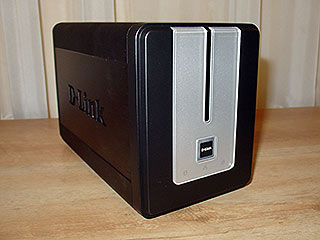 Computerworld has recently reported that in the next few years the sum total of Earth’s data will be in the two zetabyte vicinity. One Zetabyte is equal to one billion gigabytes.. in case you were wondering.
Computerworld has recently reported that in the next few years the sum total of Earth’s data will be in the two zetabyte vicinity. One Zetabyte is equal to one billion gigabytes.. in case you were wondering.
My personal and family data storage is still a little off that, but it has increased significantly since the birth of our child four years ago. This data is mainly in the form of digital photos and videos or work documents and it is all over the place: DVDs, CDs, hard drives in different PCs, etc.
The D-Link DNS-323 NAS RAID box offers a relatively inexpensive long term storage solution which can keep all your data in one place, allow universal access and when setup as a RAID 1 device, secure it from hardware gremlins.
Read on for more..
At a Glance
As a network storage solution, the DNS-323 has everything the tech savvy user would expect: Gigabit Ethernet, dual SATA drives, print server capability via USB, Auto HD spin-down settings and of course RAID. The package contains a power supply, as well as a user guide along with some other miscellaneous paperwork.
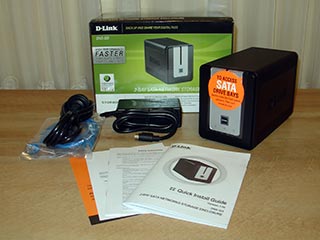 The unit is finished in stylish black aluminium and at 19.5 x 10 x 12.5cm is a little larger than three 3.5” hard disk drives. There is an on/off button located on the front in the form of a D-Link logo – which is just above three LEDs providing network and drive access notification.
The unit is finished in stylish black aluminium and at 19.5 x 10 x 12.5cm is a little larger than three 3.5” hard disk drives. There is an on/off button located on the front in the form of a D-Link logo – which is just above three LEDs providing network and drive access notification.
The rear is populated by an exhaust fan vent, a USB port, Gigabit Ethernet and a power supply port. On either side of the fan vent rest two sturdy hard drive removal levers, should you want to upgrade or replace a failed drive.
Internally, the unit contains two SATA drive bays which are almost too easily accessed by simply sliding up the unit’s face plate.
What is a NAS RAID Box Anyway?
NAS stands for Networked Attached Storage and refers to a storage device that connects directly to your network via Ethernet (or sometimes wifi). This allows the unit to be accessed by any computer on your network – or even across the Internet. Unlike regular external hard drives, NAS devices do not need to be directly attached to a computer to function.
RAID used to be associated with expensive high end servers but as consumer data has increased in size and importance – RAID is becoming more and more available to average-Joe consumers. RAID stands for Redundant Array of Inexpensive/Independent Disks and is basically a technology to improve reliability and performance of large amounts of storage space.
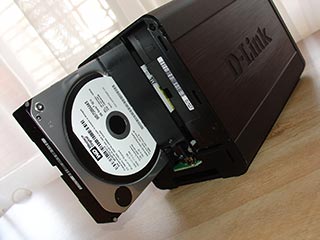 There are many RAID levels but the DNS-323 supports the two most common in the consumer market – RAID 0 and RAID 1. With the DNS-323, RAID 0 (also known as spanning) allows you to set up the two SATA drives to appear as one large drive. For example, two 750GB drives would appear as approximately 1500GB. I say approximately because with overheads and inconsistencies in how we count mega/gigabytes, one is always short changed. Without getting technical, RAID 0 offers an improvement in drive performance but offers no fault tolerance. If one of the two installed drives fail, all data is lost.
There are many RAID levels but the DNS-323 supports the two most common in the consumer market – RAID 0 and RAID 1. With the DNS-323, RAID 0 (also known as spanning) allows you to set up the two SATA drives to appear as one large drive. For example, two 750GB drives would appear as approximately 1500GB. I say approximately because with overheads and inconsistencies in how we count mega/gigabytes, one is always short changed. Without getting technical, RAID 0 offers an improvement in drive performance but offers no fault tolerance. If one of the two installed drives fail, all data is lost.
RAID 1 (also known as mirroring) sets up two drives as a mirrored set which usually provides little (if any) improvement in performance, but offers excellent protection against hardware failure. In a RAID 1 configuration, the two hard drives in the DNS-323 contain exactly the same information. This online backup comes at a price, however: The two 750Gb drives from our earlier example would allow for only 750Gb of usable storage space, albeit with far greater resistance to hardware failure.
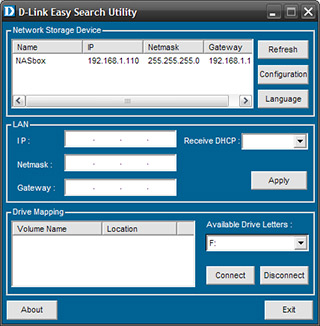
Setup
After dropping in two 750GB SATA drives, I plugged in the power cable, connected the DNS-323 to my router via gigabit Ethernet cable and was ready to go. I pushed the unit’s D-Link/on button which started to flash blue as it fired up. I quickly jumped into my router setup page and found that the D-Link had been issued the the next available IP address via DHCP. I opened a new browser tab, typed in the address and wammo.. a neat login screen met me.
For those less willing to find the network address via their router, D-Link also provides a small tool for locating the DNS-323. The D-Link Easy Search utility also allows you to easily map the device to a drive letter and offers a direct link to the DNS-323’s configuration page. Being my first adventure in NAS/RAID boxes, I found it very easy to setup the device without this tool but its inclusion should help make the transition to mass network storage a little easier for Joe “What the hell is an IP address?” Average.
After logging in (via a web browser) I quickly ran through the configuration pages and effortlessly had the DNS-323 turn my two 750GB hard drives into a single RAID 1 (mirrored) drive. As mentioned earlier, RAID 1 mirroring effectively halves the storage capacity but provides excellent peace of mind. In short – should one drive fail, the other will act as a completely up to date mirror of the failed drive.
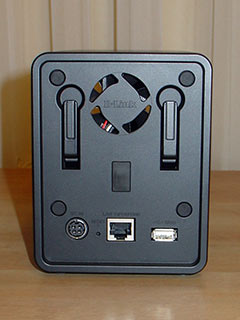 The DNS-323 buzzed away and a progress meter appeared in my browser to let me know how the RAID initialisation was going. About ten minutes later my browser displayed, “SUCCESS” and prompted to me to reboot the DNS-323. I’ve always considered RAID and NAS to be a little on the technical side, but this was child’s play.
The DNS-323 buzzed away and a progress meter appeared in my browser to let me know how the RAID initialisation was going. About ten minutes later my browser displayed, “SUCCESS” and prompted to me to reboot the DNS-323. I’ve always considered RAID and NAS to be a little on the technical side, but this was child’s play.
After a reboot I was up and running. I spent the next few hours transferring data to the drive from various destinations across my network without any problems. While transferring my files to the DNS-323 it got rather warm to the touch, but I suspect this is the whole point of the heat dispersing aluminium casing. Throughout the transfers, the box reported temperatures no greater than 49 degrees Celsius.
Considering the room temperature was in the thirties during the transfer, I found the temperature of the device to be quite acceptable. Under more sedate conditions, the unit displaced far less heat and was merely warm to the touch – even under load. Typical temperatures reported were in the high 30s.
Living with the DNS-323
Over the past two months, the DNS-323 has become the hub of all our family’s data from audio/video to office documents and it hasn’t missed a beat. The drive is incredibly handy and really, once all the bulk of your data has been transferred to it, the DNS-323 looks after itself.
The unit automatically sets up global access to the NAS at (IP address)/volume_1. This can be overridden by setting up users or groups of users and be used to limit access to specific areas of the drive/limit privileges – ie: read only access.
The unit has built in FTP server/Universal Plug and Play AV Server/ITunes Server capabilities and if required a DHCP server can be engaged.
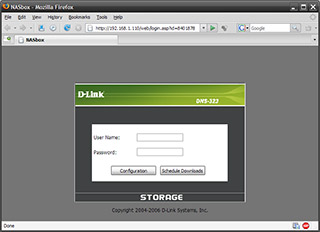
Print Server
I connected my Canon IP4300 photo printer to the DNS-323 via USB and after turning it on, found it was recognised by visiting the DNS-323’s status page. Setting up a printer was relatively easy – after I worked through an odd problem. While originally setting up the DNS-323 I gave it the network device name, “NASbox” which caused me some trouble. It appears that either Windows XP or the DNS-323 had a problem with the capital letters in the device name. When I changed the name to “nasbox” (all lower case) everything worked fine, however.
Browsing to the unit’s IP address (in Windows explorer) revealed the shared folder Volume_1 as well as the newly connected networked printer, oddly named “IP.” Double clicking the printer caused Windows to prompt me to install the drivers – which I did. Quite simple really.
While I had relatively little trouble setting up the printer, it is worth noting that the manual is fairly light in this regard. To help out less technical users, D-Link could perhaps add a printing wizard to either the DNS-323’s setup page or provide assistance via its “Easy Search” utility.
Conclusion
I have been very impressed with the D-Link’s performance throughout my two months of testing. It is easy to setup, works exactly as you would expect once it’s loaded up with files and has all the features you would expect for a device of this kind.
The device ran fairly quietly – even when under load – and never got hot enough to warrant any sort of concern. When creating users, the unit imposed an eight character password limit which is a little low for my liking but beyond this, the DNS-323 has little going against it.
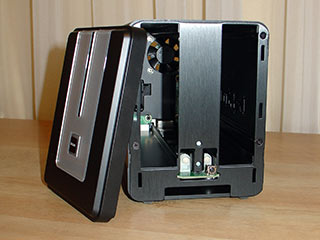 In fact, the only improvements I would suggest would be to add a “magic packet” power on feature and perhaps the ability to plug in an external drive via USB. Of course, after all is said and done, snazzy features are not what a RAID NAS box is all about. It’s about peace of mind.
In fact, the only improvements I would suggest would be to add a “magic packet” power on feature and perhaps the ability to plug in an external drive via USB. Of course, after all is said and done, snazzy features are not what a RAID NAS box is all about. It’s about peace of mind.
And in this regard it passed admirably: The more I used the unit, the more convinced I became that the DNS-323 was a trustworthy storage solution for my family’s precious data.
The D-Link DNS-323 has a street price of around $300AU and is available now. For more information, including where you can pick up one of these sleek boxes, surf on over to D-Link’s website.
|
+ |
– |
|
|



